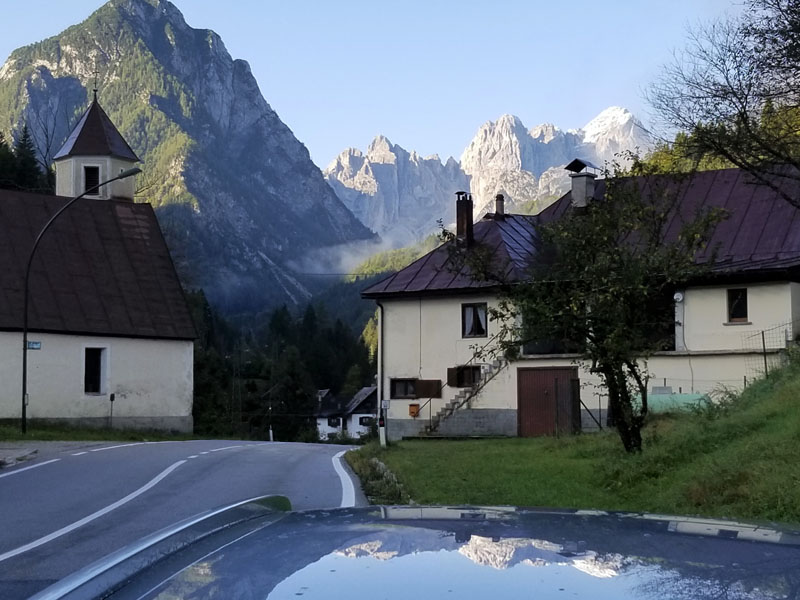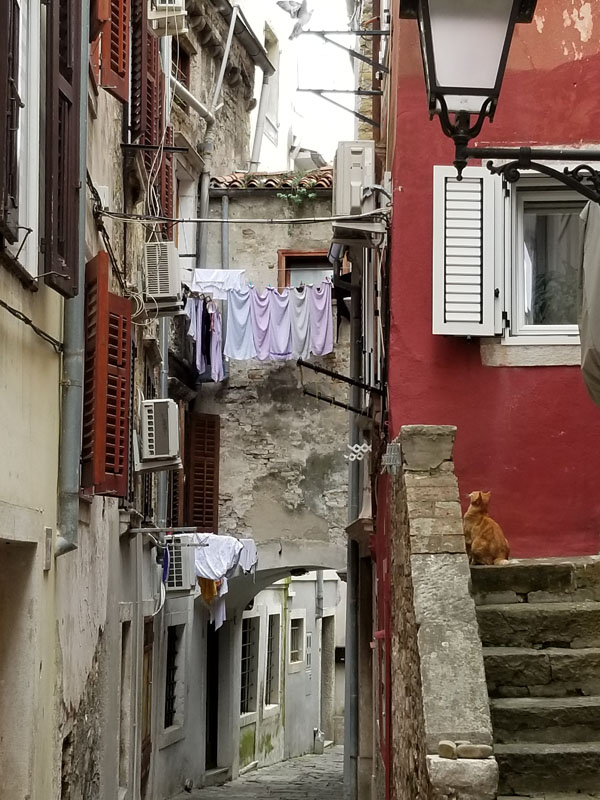Exploring Slovenia From Kranjska Gora to Piran
Kranjska Gora – northern gateway to the Soča Valley – became our base for several days. It’s a picturesque alpine village popular for both winter sports and summer hiking trails. September is a glorious time to visit. The crowds have departed; the air is crisp; and one can absorb the atmosphere of daily life in an almost tourist-free Slovenian village.

We stayed in a charming guesthouse across the street from a traditional Kranjska Gora Liznjek style house. The staff was wonderful and offered great suggestions for exploring the area.

Ask any of the locals in Kranjska Gora to direct you to the forest trail that leads to Jasna. On a cloudy day, the earthy aroma of rich soil fills the air; a variety of wild mushrooms that look as though they were made from porcelain dot the forest floor; turquoise streams tumble over stone ledges, and sturdy, wooden exercise equipment that comes with instructions, are scattered at ten-minute intervals on the edge of the forest trail.






Jasna consists of two crystal-clear, man-made lakes surrounded by mountains. The setting is idyllic. In the summer, the lakes become a tranquil swimming pool edged by golden beach sand for sunbathing and relaxing. Plan on having lunch or at least a cup of coffee and pastry or a drink lakeside.



Lake Bohinj is an hour’s drive from Kranjska Gora and 20 minutes from Lake Bled. Although it involved backtracking, we chose this option to maximize our time in both areas. Lake Bohinj-the largest lake in Slovenia – feels much more isolated and less developed than Lake Bled, where tour buses clog the narrow streets, parking is impossible, and elegant five-star hotels line the lake.


After a visit to admire Lake Bohinj (in the summer, it’s ideal for kayaking and paddle-boarding), continue along the road that hugs the lake and be on the lookout for the signs to Savica Waterfall/Slap Savica. Park in the lot and follow the path up to the waterfall. It’s only a 20-minute walk, and although it’s not difficult, it is steep and involves climbing several hundred steps. This mesmerizing waterfall is the source of the Savica Bohinj River that feeds into Lake Bohinj. The path leads to a viewing platform. For a closer look, continue along the path that leads to the base of the waterfall.

Another highlight awaits, so hop in your car and drive a short distance to the Vogel Cable Car. Take the cable car to the upper station and plan on spending some time taking in the views of Lake Bohinj and the alps. Bring a picnic lunch or enjoy a meal in the restaurant while savoring your surroundings. For hikers, there’s a trail that will lead you to the summit. The roundtrip will take you approximately four hours.


Bovec, wrapped in the surrounding Julian Alps, is the main town in the Soča Valley. The valley is of historical significance as it was part of the Isonzo Front, where fierce battles raged during the First World War between armies who dug in on opposite sides of the valley. Remnants of the war are still present in the valley. There are fortresses such as Kluže outside Bovec and war trails known today as the “Walks of Peace” – five marked trails, where trenches and bunkers can be found, and the outdoor Ravelnik museum. The picturesque town of Kobarid, home to an informative First World War museum, is also where Ernest Hemingway wrote his internationally acclaimed novel “A Farewell to Arms,” set against the backdrop of the First World War.
*Note: For information about the Soča Valley, visit the Bovec tourist office where the staff is most helpful.
The Tomlin Gorges are a twenty-minute drive from Kobarid. Treat yourself to an hour and a half, unchallenging, circular walk in yet another unforgettable Slovenian outdoor wonderland.


Driving from Kranjska Gora to Piran (2 ½ hours)
We bade farewell to Kranjska Gora and the Soča Valley with a final stop in Kanal Ob Soci, a tiny medieval town with a semi-circular bridge that straddles the banks of the Soča river. The terrace café, Rafaelo, offers not only a gorgeous view of this storybook village but delicious, generous portions of ice cream, cakes, and pastries.


Piran is love at first sight. The fishing and pleasure boats bob in the harbor under glorious blue skies; the ocean is so calm and crystal clear that a good swimmer could swim all the way to Trieste-Italy; and Tartini Square – named after violinist and composer Giuseppe Tartini – is alive with locals conversing, children riding their bicycles, and diners enjoying a meal in the restaurants that encircle the square.



Across the plaza and up a tiny picturesque cobblestone street is the newly renovated and gorgeous Memento B&B. The original four-story house was owned by the current owner – Anze’s – grandfather, who eventually sold the house in his old age. Anze repurchased it several years ago, and together with his wife and childhood friend Micha, did a spectacular job on renovating it. They maintained the beautiful original stone, introduced brick, glass, wood, and tasteful, uncluttered interior design.




Piran’s waterfront is lined with cafés where locals and tourists enjoy gelato, pastries, wine, and gourmet coffee drinks while looking out at the swimmers, the boats, and the Italian coast in the distance.

The narrow, winding, cobbled lanes that lead off Tartini Square are magical. This is where one experiences a truly authentic Slovenian fishing town. The weathered stones and rooftops; the laundry strung high above the streets to dry; the aromas of cooking; pets wandering freely; and the muted sounds of conversations drifting outdoors.


Seafood in Piran is fresh out of the ocean and prepared to perfection. Choose one of the small unpretentious restaurants tucked into the alleys where you’ll enjoy the best seafood and a great ambiance.


The Postojna Caves are a one-hour drive from Piran. Book online, and don’t miss this mindboggling experience. There are 24 kilometers of underground caves, 4 kilometers are open to visitors. The size, the shapes, the colors, the textures of the stalagmites and stalactites are indescribable. It’s impossible to take it all in. It’s sensory overload. They are like silk, like ivory, like marble, like the most delicate lace, like snowflakes, like gelato, like ornate sculptures. They are nature’s works of art. One almost expects fairies and dragons to come flying by. You enter the caves on a train accompanied by your guide. He leads you on foot to explore for a couple of kilometers, and you exit again by train.




The Škocjan caves. Due to a lack of time, we did not manage to visit the Škocjan Caves, which were described to us as massive underground canyons, but not as beautiful as the Postojna caves. They are a 45-minute drive from Piran.
Note: *Kranjska Gora Guesthouse: Apartment Guesthouse Berghi.
